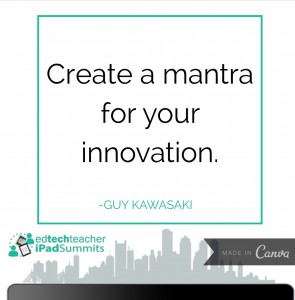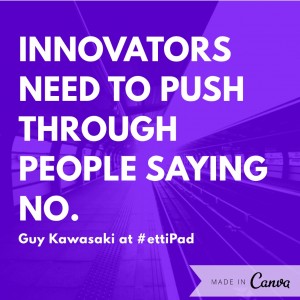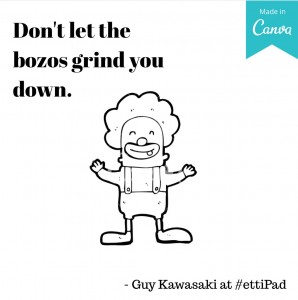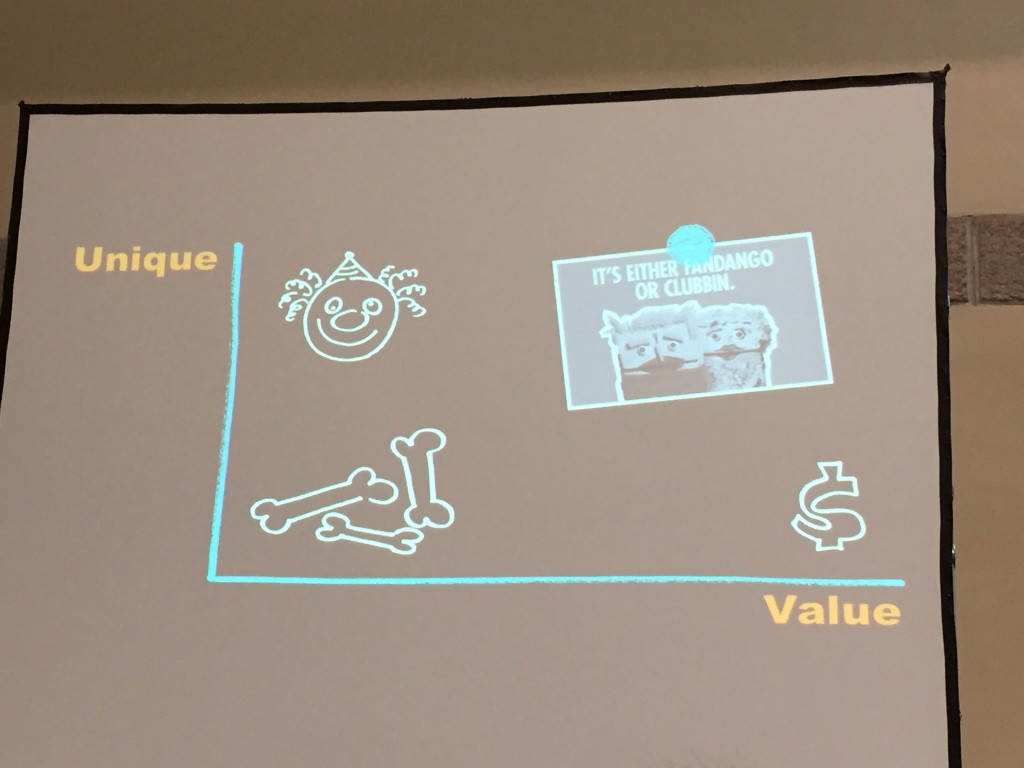Guy Kawasaki is the Chief Evangelist of Canva and an executive fellow at the Haas School of Business at U.C. Berkeley. As a former Chief Evangelist at Apple, he begins by saying that he is perfectly comfortable in this environment and especially happy to be working with teachers. To begin, he tells the story of working at Apple, meeting Steve Jobs, and the culture of being at Macintosh. Given his experience with tech speeches, he likes to give “Top 10” speeches (hint: he has fun with this concept).
1. Make Meaning
Great innovation is motivated by the desire to make meaning and change the world. The companies who succeed began because they want to make the world a better place. However, if the sole of an organization is to make money, then they are doomed to failure. Guy then shows a number of companies that succeeded. Apple made meaning by bringing computing to the world. Google democratized information and ebay democratized commerce. These companies all changed the world and made meaning for the world.
2. Make a Mantra for the Meaning
Think about a 2-word statement about your school, classroom, or environment. A mantra is not a mission statement – the latter are long, generalized, and without meaning. Guy challenges everyone to create something that explains the meaning. As an example, Nike stands for authentic athletic performance and FedEx for peace of mind. Create a mantra for innovation to keep everyone on the same page and to communicate your ideas.

3. Perspective for Great Innovation
To explain this concept, Guy walks through the innovation in ice. Initially, Ice 1.0 resulted in ice harvesting during winter. By Ice 2.0, ice could be stored in factories and then delivered to your house. As time progressed, Ice 3.0 evolved as the refrigerator. The danger is that the workers of each layer of innovation did not make the jump to the next level. Too many institutions define themselves based on what they do rather than what they provide. Great innovation happens by jumping or creating the next innovation curve.
4. Roll the Dice – 5 qualities of great innovation
Great products and services offer a number of intrinsic elements to support how you can jump the innovation curve.
- Deep – as an example, the Reef sandal has a built-in bottle opener. It moves beyond the device.
- Intelligent – Ford has created an element called “MyKey” which allows a user to program a key for a top speed. While the car may have tremendous power, the user can control what is available.
- Complete – Amazon offers total service. Beyond selling books, it hosts your store, sells services.
- Empowering – Consider the power of using Apple. Great products and services
- Elegant – Someone cares about the overall experience.
5. Don’t Worry Be Crappy
Guy tells the story of one of the original Macs. It had a small, monochrome screen and minimal capabilities on today’s standards. However, they saw their product as revolutionary. If they had waited for the technology to improve, they never would have shipped the first device. However, they looked at how to create new innovations that are deep, intelligent, complete, empowering, and elegant. Too many entrepreneurs ship their products too late rather than too early. He says that if you don’t cringe with the first version, then you didn’t ship fast enough. Too often, we wait to share our innovation because of concerns about quality. However, by waiting, the opportunity may disappear. Innovators cringe about what first ships.
6. Let 100 Flowers Blossom
As an innovator, you may think that you have in mind an exact user or customer. However, the discovery may be that an unintended user uses a product in an unintended way. Think about curriculum and content. Innovation is difficult, so even if the product or service is embraced in an unintended way, embrace it. As an example, Apple survived because of Aldus PageMaker. It was not an intended plan. The market decided that Apple existed as a desktop publishing machine rather than a word processor or spreadsheet generation tool. Another example was Avon’s Skin-So-Soft. While intended to be for skin care, most people use it as an insect repellant.
7. Polarize People
Great innovation polarizes people. Think about Apple, Android, or TiVo. A true innovation makes people take a position to defend the brand. While it is not an intention, it is a consequence. A worst case scenario is to not be on anyone’s radar.
8. Churn Baby Churn
The hardest part of innovation is that you have to exist within denial. The naysayers will say that it can’t/shouldn’t be done and isn’t necessary. In order to jump the innovation curve, you need to ignore those people until your idea has shipped. At that point, you then have to shift perspectives and start listening to the customer base in order to get feedback.
9. Niche Thyself
Think about a graph with value on the x-axis and uniqueness on the y-axis. Think about Dell. They have high value and low uniqueness. On the other hand, a moron has high uniqueness and no value. The worst possible corner is low value and low uniqueness. Consider the model of pets.com. Supply chain managers wanted to remove pet food stores from the process. The value proposition was to eliminate the store, but they did not consider the fact that food had to be shipped. In the end, the cost of shipping equaled the margin lost on stores and did not add any additional convenience.
The goal is to be high value and high uniqueness. This applies to classrooms and schools as well as businesses. Consider the model of Fandango – to be able to buy a ticket and then go straight into a movie – or the Breitling watch that includes the feature to send an emergency signal to save your life. It’s a unique and valuable product with a unique and valuable proposition.
10. Perfect Your Pitch
The first step is to customize your introduction. Think about how to personalize that first experience. As a story, Guy talks about presenting to the group at LG. He decided that he wanted to share pictures of his LG washer and dryer. Then, he shares other stories for how he makes every audience feel special in the ways that he begins his talks.
Follow the 10-20-30 Rule when making a presentation. First off, the optimal number of slides in a session is “10.” Keep a pitch to 20 minutes. 30 point font is the smallest font size that should ever be used. The other way to make presentations better is to use a black or dark background because white says “I opened PowerPoint and just started typing.” Think about going to the movie, the credits never appear as black text on a while background.
11. Don’t let the Bozos Grind You Down
There are two types of bozos in the crowd. The first kind are the ones that are visible “losers” who you know are not successful. The dangerous bozos are the people who appear successful, but that does not always parse to smart. “Bozality is like the flu.” From here, Guy provides the intellectual version of a flu shot.
From here, Guy provides examples of powerful people who have made dangerously stupid statements such as the CEO of IBM who swore the world only had room for 5 computers or the person who from Western Union said that the telephone had too many shortcomings to become successful. The greatest danger to innovation is the people who cannot see the vision.
The Innovation Curve & Schools
A great question came from the audience. “How do you jump the innovation curve in schools.” Guy responded with “don’t underestimate the democratization of education.” He cites the rapid advancement of MOOCs and Open Courses as well as the trend that more students use YouTube than Google to learn new things. Consider the power of Pinterest – more people use that as a means to learn new things. The real key is to consider how to jump to the next innovation curve.




